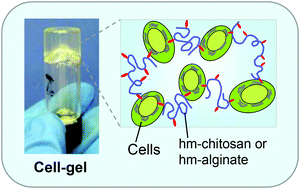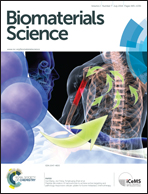Reversible gelation of cells using self-assembling hydrophobically-modified biopolymers: towards self-assembly of tissue
Abstract
Polymer hydrogels have long been used to hold and culture biological cells within their three-dimensional (3-D) matrices. Typically, in such cases, the cells are passively entrapped in a mesh of polymer chains. Here, we demonstrate an alternate approach where cells serve as active structural elements (crosslinks) within a polymer gel network. The polymers used in this context are hydrophobically modified (hm) derivatives of common biopolymers such as chitosan and alginate. We show that hm-polymers rapidly transform a liquid suspension of cells into an elastic gel. In contrast, the native biopolymers (without hydrophobes) do not cause such gelation. Gelation occurs because the hydrophobes on the polymer get embedded within the hydrophobic interiors of cell bilayer membranes. The polymer chains thus connect the cells into a 3-D sample-spanning network, with the cells serving as the junctions in the network. We demonstrate that a variety of cell types, including blood cells, endothelial cells, and breast cancer cells can be gelled by this approach. Cells gelled by hm-alginate are shown to remain viable within the network. Also, since the crosslinking mechanism is based on hydrophobic interactions, we show that the addition of supramolecules with hydrophobic binding pockets can reverse the gelation and release the cells. Cell-gels can be employed as injectable biomaterials since the connections in the network are susceptible to shear, but recover rapidly once shear is stopped. The overall approach provides a simple route towards the directed assembly of cell clusters and potentially to living tissue.


 Please wait while we load your content...
Please wait while we load your content...